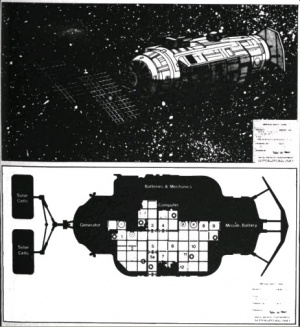4-C/D class Automated Interdiction Satellite
Revision as of 23:38, 23 December 2016 by Maksim-Smelchak (talk | contribs)
The printable version is no longer supported and may have rendering errors. Please update your browser bookmarks and please use the default browser print function instead.
| Imperial Standard Automated Interdiction Satellite | |
|---|---|
| [[File:|250px]] | |
| Type: WP 4-C/D | |
| Size | 300 Tons |
| Hull Configuration | [[{{{hull}}}]] |
| Tech Level | TL–14 |
| Engineering | |
| Computer | |
| Jump | J-0 |
| Maneuver | 0.25 G |
| Armaments | |
| Hardpoints | 4 |
| Accommodations | |
| Staterooms | 0 |
| Personnel | |
| Crew | None |
| High/Mid Passengers | 0 |
| Payload | |
| Cargo | 0 Tons |
| Fuel tank | 0 Tons |
| Construction | |
| Origin | Third Imperium |
| Price | |
| Cost | MCr267.13 |
| Source | |
| Canon | Unpublished, fan design |
A heavily-armed, automated satellite used by the Imperial Navy and Scout Service to enforce interdiction orders on worlds where constant manned presence would be unfeasible or uneconomic.
Description (Specifications)
USP 33011DO-640500-35003-0
These satellites are un-streamlined and cylindrical in configuration with a meteor/debris shield and solar cell vanes. They are typically armed with:
- One missile rack with a magazine of 40 missiles
- Four turrets:
- Two of two beam lasers
- One sandcaster
- One or two fusion guns.
These satellites are equipped with:
- Level 5 nuclear dampers
- Level 6 hull armor
History & Background (Dossier)
The Type SMU-4C was first placed in service in 1035 and is still common throughout the Spinward Marches.
Several type variants exist to cater for specific or unusual requirements:
- The 4C is a typical Navy model.
- The 4D is a Scout Service model identical except for the computer and sensor packages.
- A number of similar types without the heavy armament can be found on observation missions or as information/marker buoys.
References & Contributors (Sources)
This list of sources was used by the Traveller Wiki Editorial Team and individual contributors to compose this article. Copyrighted material is used under license from Far Future Enterprises or by permission of the author. The page history lists all of the contributions.
